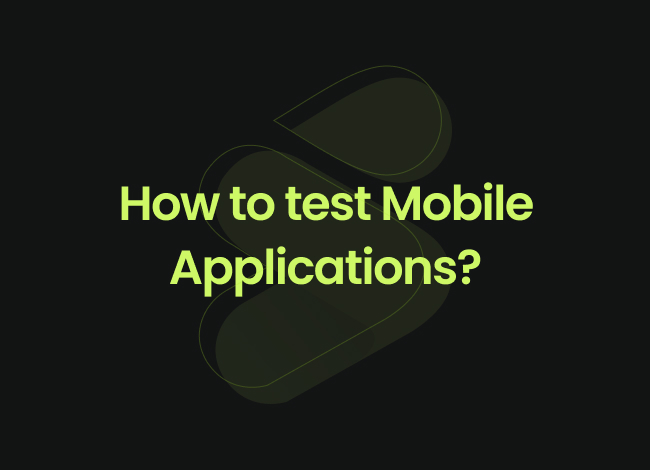Introduction
Nowadays mobile phones have become one of the most important parts of our lives. These phones play a major role in our daily life chores and help us to perform them more efficiently. Considering this much involvement of cell phones, now every other application or software is created to run perfectly on mobile phones. Due to this, learning how to test mobile applications is very important for making sure your application reaches a maximum number of users. In our mobile application testing guide we will clearly explain mobile app testing, its types and other related things. So just stay with me to learn more about how to test mobile applications.

What is Mobile App Testing?
In our mobile application testing guide the very first thing that we will discuss is what is mobile testing. Usually whenever applications or software are developed, they are also developed to work on mobile phones. These devices do have different specifications and requirements than computers. To make sure they work perfectly, different mobile app testing best practices are applied on them to make sure they are flawless. This testing of applications regarding making them work on mobile phones is called mobile phone testing.
In our mobile application testing guide, the next thing that we will discuss is the types of mobile app testing. So let’s move on to the next step.
Types of Mobile Apps
Mobile app testing is a very popular form of testing where we test different types of applications to ensure they work perfectly on a mobile phone. There are several types of mobile apps that can be made robust by applying mobile app testing best practices. Following are some of the most famous types mobile apps:
Web Apps
The next type of apps to be mentioned in our blog of how to do mobile app testing is web apps. These apps work through a browser on your phone. They are not installed like native apps. Instead, you access them by entering a website address. They look like regular apps but run using the internet. Web apps are the best apps on which the mobile application testing techniques can be easily applied.
Hybrid Apps
The next type of apps that you can come across while learning how to perform mobile app testing is hybrid apps. As the name suggests, hybrid apps mix the features of both native and web apps. They are made using web technologies but can be installed on your phone like native apps. They work on different platforms and are cheaper to build. This is one of the most common types of apps that can be discussed whenever you are learning how to perform mobile app testing.
Native Apps
This is the type of apps that can be easily tested by applying mobile application testing techniques is native apps. These native apps are made to work on a specific mobile platform, like Android or iOS. They run smoothly and use the phone’s features These apps are often very fast and reliable. In our blog about how to do mobile app testing this is the very first type of apps to be discussed.
Cross-Platform Apps
By properly using the mobile app testing process, we can easily test the cross platform apps. Cross-platform apps are made to work on multiple mobile platforms, like Android and iOS, using a single codebase. These apps save time and money because they don’t need separate versions for each platform. So always deploy the best mobile app testing process to test your mobile apps.
Progressive Web Apps
Progressive Web Apps (PWAs) are like regular websites but act more like apps on your phone. You don’t need to download them from an app store. Instead, you visit a website, and it works just like an app. They load fast, work even when you’re offline, and you can add them to your home screen, so they feel just like a real app for example twitter lite.
Business Apps
Business apps are created to help people with their work. They include things like email, calendars, and office tools. These apps make it easier to do tasks and stay organized on the go. This is a very important type of app that is usually added in all mobile app testing checklists.
How to Test Mobile Applications?

Now comes the last stage of our blog where we will discuss how to write mobile app test cases. Here we will shed light upon all the important steps that one must follow to make his testing robust and effective. Following points can clearly explain how to write mobile app test cases:
Define Test Objectives
The very first step to take while learning mobile app testing step by step is to define your clear objectives for testing. Before starting the testing process, it’s important to set clear objectives. This means understanding what your app is supposed to do, who will use it, and what challenges it might face. Clear objectives help keep your testing focused and aligned with your app’s goals. Defining clear test objectives is a very important step to learn mobile app testing step by step.
Creating Test Cases
The next step that testers follow in every mobile app testing including how to test iOS applications is to create test cases. These test cases are detailed plans that outline how you’ll test your app. Test cases cover everything from user actions to how the app handles errors. They ensure every part of your app is tested thoroughly. So even if you are learning how to test iOS applications, creating test cases is one of the most important steps.
Choosing Testing Tools
In the third step of how to test Android applications, we go for choosing the right tools for the right job. Choosing the right testing tools is key to an efficient process. Depending on your app and testing needs, tools like Appium, Selenium, and Xcode can be very helpful. These tools make your testing process smoother and more effective.
Executing Test Cases
Whether you are learning how to test Android applications or any other form of testing, the next step after creating test cases and the tools is to execute these tests. Once your test cases are ready, it’s time to execute them. Run the tests carefully, document the results, and look for any issues. This phase is crucial as it checks if your app functions and performs as expected.
Automating Testing (if applicable)
Automation can make your testing process faster and more thorough. It’s especially useful for repetitive tasks like regression testing. By automating parts of the testing, you can improve efficiency and ensure a more detailed review of your app.
Conclusion
Mobile applications are an integral part of all mobile devices and testing them to ensure they work perfectly on phones can help boost a company’s sales. This testing not only comes with several types, but also has numerous benefits. In case you are looking for a reliable mobile testing company, Siznam can be the one you can trust.
People Also Ask
Mobile applications are tested through various types of testing, including functional, usability, performance, compatibility, and security testing. Testers typically use real devices, emulators, or simulators to check if the app functions correctly on different operating systems (iOS, Android), device models, and screen sizes. Automated testing tools like Appium or manual testing methods are commonly used.
To check an application on a mobile device, you can install it on the target device and conduct manual testing. This includes verifying functionality, usability, and performance aspects to ensure the app meets user requirements. Mobile device emulators or cloud-based testing platforms can also be used to test across multiple devices and environments.
To test mobile applications on a PC, use emulators or simulators that mimic mobile environments, such as Android Studio Emulator for Android apps or Xcode Simulator for iOS apps. Cloud-based platforms like BrowserStack or Sauce Labs also allow testing across various mobile devices from a PC, enabling testers to check app functionality, responsiveness, and compatibility without needing physical devices.
Testing an application involves several stages, including requirement analysis, test planning, test case development, and executing different types of tests like functional, usability, performance, compatibility, and security testing. Automated tools and manual testing methods are used to identify bugs, validate features, and ensure the application meets its intended requirements.






